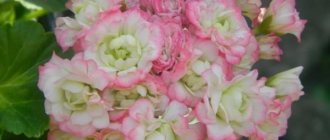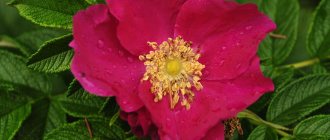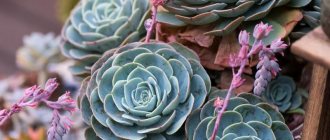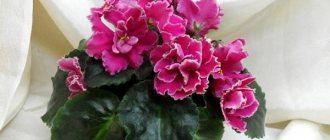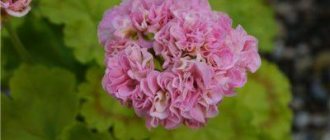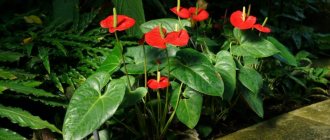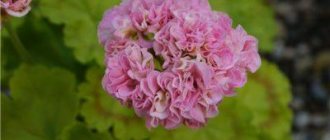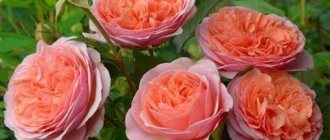Author of the article: Olga Viktorovna | Updated: 02/19/2022
XXI CENTURY Candy Fudge Scented water
266 ₽ More details
Video baby monitor Motorola MBP36S (white)
12900 ₽ More details
Children's onesies
Pelargonium is no longer that grandmother’s plant with inflorescences resembling umbrellas. This category is so diverse that it requires much more serious consideration. For example, this group also includes star pelargonium - a plant that certainly does not resemble the classic geranium known to many.
Overview of varieties
Star pelargonium is a fairly large category that includes a large number of varieties. Before making your choice, you should study their main characteristics in more detail. Only in this case will you select truly worthy specimens that will harmoniously complement your flower collection.
Among the popular varieties, it is worth highlighting Golden, Green, Joann, Jean cows, Lawrence, Lisa Jo, Pink, Polestar, Rhapsody, Rushmoor golden ruffles, Sagitarius, Sutarves bosna, Joanna, Diana, Caroline, Hudson, etc.
Lotta Lundberg
Such pelargonium with bright pink petals will certainly not leave anyone indifferent. Its buds resemble sharp miniature stars. The peduncle of this specimen is quite strong, but has a shade more prone to brown. As for the leaf plate, it is covered in places with dark stains.
This star-shaped shrub is compact, making it a great addition to any home collection. But if you eventually want to arrange a flowerbed or some kind of alpine hill in your garden, be sure to give preference to this variety.
Bob Newing
This flower specimen primarily stands out among the entire variety of varieties for its bright pink-red petals. The buds form lush inflorescences, which are also openwork. The main characteristics of this variety also include a high peduncle. The leaves of this geranium are tricolor.
Bronze Butterfly
This variety of star pelargonium is valued by domestic flower growers not only for its beautiful and bright inflorescences. The foliage of the plant deserves special attention. It has a rich green color, and in the center there is a darker pattern, reminiscent of a butterfly, which turns bronze in the sun. The star-shaped inflorescences of this specimen are quite large and peach-colored. They are also terry, so they look very voluminous.
Rushmoor Bondi Blue
This flower specimen is worth paying attention to not only because its buds are very beautiful. The leaf plate of such a plant also looks aesthetically pleasing. It has a peculiar pattern in the center that complements the miniature composition. The inflorescences of the Rushmoor Bondi Blue variety are double, their shape is somewhat curved, but looks elegant. Those who want to add a specimen with delicate purple petals to their flower collection should pay attention to this variety of homemade geranium.
Little Linda
What is primarily notable about this variety is its golden foliage. Its petals are double and light pink in color. Moreover, the buds consist of narrow, elongated petals, which look quite aesthetically pleasing. It’s worth purchasing such a flower specimen, if only because it blooms very often, so it will delight you with bright inflorescences almost all year round.
Bev Foster Stellar
The Foster Stellar variety of geranium is a miniature specimen. The leaf blade of such a flower is green, but its zonal ring is usually darkened. You should definitely include this plant in your collection, because it has very beautiful, bright, double buds. Moreover, the color of the petals in this case is multifaceted, therefore it includes pink, crimson, orange, and red shades.
This compact variety of homemade geranium will appeal to many. It does not develop very intensively, but does not require special care. In addition, you will certainly be satisfied with the bright and abundant flowering.
Diseases
Pelargoniums can be affected by pests and diseases, and have various problems associated with deficiencies in care and maintenance. Next, we will look at the most common problems that arise when growing these beautiful plants.
Edema
Some gardeners notice the appearance of soft, watery pads on the leaves of plants. These defects occur due to waterlogging of the soil, and in order to eliminate the swelling, it is necessary to urgently reduce watering.
Leaves fall, stems become bare
Similar problems arise if the stellars are kept in an insufficiently bright place. To eliminate unsightly “flaws in appearance,” move the pot with the plant to the most well-lit windowsill in the house.
Gray rot
This disease is the most common one that occurs in this type of pelargonium. The pathology is caused by a fungus and occurs due to excessive waterlogging of the plant. Note that gray rot is contagious, so radical and urgent measures must be taken to save the plant .
It is necessary to remove and burn the diseased leaves, treat the entire plant and those next to it with a fungicide using a sprayer. In addition, a mandatory measure is to reduce watering and increase the frequency of ventilation.
Pests
Of the insects, stellars pose the greatest danger:
- weevil;
- whitefly;
- aphid.
To control pests, spray the plant with an appropriate insecticide.
Stellar pelargoniums
Stellar pelargoniums
Post by AEA » 29 Oct 2009, 21:59
Stellar pelargoniums
About stellars. These, in my opinion, are the most beautiful among pelargoniums. All stellars have very beautiful leaves, similar to maple leaves.
Foliage color may vary. Here is a chocolate one in the bright sun, there can be green with a dark zone, gold, there are three-color ones, but I’ll show you a little later, but for now about flowers. Stellar flowers look like stars; they are also called star-shaped pelargoniums. Flowers can be simple or double. The inflorescences are both loose and dense in different varieties. I like both of them.
Loose inflorescences of simple flowers look like a flock of small butterflies.
And this is a dense inflorescence of simple flowers.
Terry inoculations of stellars look like this.
or like this
Stellar pelargoniums
Post by AEA » 01 Nov 2009, 13:01
And this is a bush of an entirely young plant of a miniature variety with semi-double flowers. The entire plant is 14 cm tall.
Stellaras do not all litter, only with simple flowers, while double ones, as a rule, wither in full inflorescence and do not litter. To tear off a faded inflorescence from a bush - you still have to try. It’s the same with zonal ones - simple ones litter terribly, but not all terry ones.
Sources:
https://selo.guru/rastenievodstvo/derorativ/pelargonija/vidy-pel/stellar.html https://myorchidea.ru/geran/pelargoniya-zvezdchataya/ https://frauflora.ru/viewtopic.php?t=870
Rules and nuances of growing
Annsbrook sagitarius, Antonnia Scammell, Bicolor, Borthwood, Clatterford, Edwards, Ellison, Fireworks, Foster, Godshill - these and other varieties of star geranium are worth picking up for your flower collection. But before choosing the varieties you like, it’s worth taking a closer look at the basic rules for caring for such a plant. Of course, these flower specimens are not considered picky, but they will require more care than miniature pelargoniums.
What you should worry about first is the substrate. The soil in the pot must be slightly acidic. Be sure to dilute the earthen composition with peat and sand. Do not forget about the need for regular feeding of geraniums. To do this, you can use liquid solutions of fertilizers, which are added as the green specimen grows.
Place the flower in a pot in well-lit areas of your home, but do not allow the roots to overheat. During the summer, it is very important to shade the plants in the afternoon on hot days.
As for winter, it is advisable to provide bright lighting for geraniums - in this case, the flowering phase will be long.
In the process of caring for star geraniums, you should also worry about regular pruning. Hold this event twice a year: in spring and summer. Take proper care of star pelargonium. All that is required of you is to follow the basic recommendations for caring for your houseplant. Even a novice gardener can root it and achieve flowering, the main thing is patience and a competent approach.
Where and how to plant?
Pelargoniums take root well at home as ornamental plants. It is best to grow stellars from cuttings.
Lighting and location
Star pelargoniums love plenty of light . The best place for planting is a windowsill, and in the warm season it is best to take the plants out into the open air.
In winter, plants need additional lighting. This will help the formation of a normal number of peduncles during short daylight hours.
Soil requirements
Pelargonium stellar belongs to zonal plants - this determines special requirements for the soil. plants require a slightly acidic environment (pH 6-7). The soil also needs to be enriched with sand and peat; it is best to use liquid fertilizers for these purposes. Gardeners can come to the aid of a special soil mixture, which can be purchased in stores.
Instructions for care and planting
The most effective way to grow star pelargonium is to plant a cutting. The method will ensure the inheritance of all species characteristics and will delight with its original appearance. A plant grown from seed may not live up to the gardener's expectations .
- Watering pelargonium stellar should be normalized. More abundant watering is necessary only in hot summers, but it should only be done when the top layer of soil is completely dry.
- Star pelargonium needs to be replanted in appropriate pots. It is important to take into account that in a too large pot the number of inflorescences will be reduced, so you need to choose small pots, gradually increasing their size by only 1-2 cm.
- Pruning the plant can and should be done to form a more lush bush. it is necessary to pluck young shoots, and in the fall remove dried inflorescences and excess growth.

